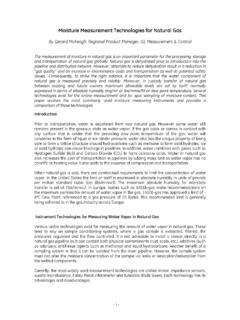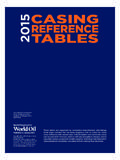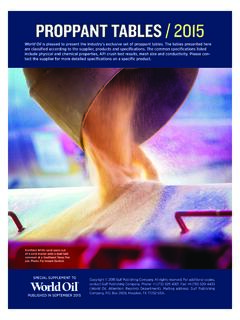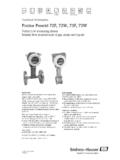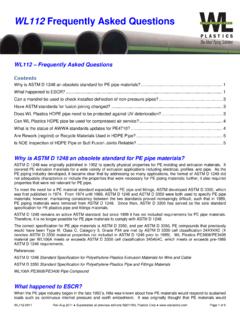Transcription of Moisture Measurement Technologies for Natural Gas
1 - 1 - Moisture Measurement Technologies for Natural Gas By Gerard McKeogh. Regional Product Manager, GE Measurement & Control The Measurement of Moisture in Natural gas is an important parameter for the processing, storage and transportation of Natural gas globally. Natural gas is dehydrated prior to introduction into the pipeline and distribution network. However, attempts to reduce dehydration result in a reduction in gas quality and an increase in maintenance costs and transportation as well as potential safety Consequently, to strike the right balance, it is important that the water component of Natural gas is measured precisely and reliably. Moreover, in custody transfer of Natural gas between existing and future owners maximum allowable levels are set by tariff, normally expressed in terms of absolute humidity (mg/m3 or lbs/mmscfh) or dew point temperature.
2 Several Technologies exist for the online Measurement and for spot sampling of Moisture content. This paper reviews the most commonly used Moisture measuring instruments and provides a comparison of those Technologies . Introduction Prior to transportation, water is separated from raw Natural gas. However some water still remains present in the gaseous state as water vapor. If the gas cools or comes in contact with any surface that is colder that the prevailing dew point temperature of the gas, water will condense in the form of liquid or ice. Under pressure, water also has the unique property of being able to form a lattice structure around hydrocarbons such as methane to form solid hydrates.
3 Ice or solid hydrates can cause blockage in pipelines. In addition, water combines with gases such as Hydrogen Sulfide (H2S) and Carbon Dioxide (CO2) to form corrosive acids. Water in Natural gas also increases the cost of transportation in pipelines by adding mass and as water vapor has no calorific or heating value it also adds to the expense of compression and transportation. When Natural gas is sold, there are contractual requirements to limit the concentration of water vapor. In the United States the limit or tariff is expressed in absolute humidity in units of pounds per million standard cubic feet (lbs/mmscf). The maximum absolute humidity for interstate transfer is set at 7lbs/mmscf.
4 In Europe, bodies such as EASEE-gas make recommendations on the maximum permissible amount of water vapor in the gas. EASEE-gas has approved a limit of -8 C Dew Point, referenced to a gas pressure of 70 Bar(a). This recommended limit is generally being adhered to in the gas industry across Europe. Instrument Technologies for Measuring Water Vapor in Natural Gas Various viable Technologies exist for measuring the amount of water vapor in Natural gas. These tend to rely on sample conditioning systems, where a gas sample is extracted, filtered, the pressures regulated and the flow controlled. it is not advisable to install a sensor directly in a Natural gas pipeline as it can contain both physical contaminants (rust, scale, etc.)
5 , additives (such as odorizers, antifreeze agents such as methanol) and liquid hydrocarbons. Another benefit of a sampling system is that it can be isolated from the main pipeline. However, the sample system must not alter the Moisture concentration of the sample via leaks or desorption/adsorption from the wetted components. Curently, the most widely used Measurement Technologies are chilled mirror, impedance sensors, quartz microbalance, Fabry-Perot inferometer and tuneable diode lasers. Each technology has its advantages and disadvantages. - 2 - Chilled Mirrors There are two basic categories of chilled mirror hygrometers: manually operated and automated. Automated chilled mirrors are further categorized into cycling chilled mirrors and equilibrium chilled mirrors.
6 Chilled mirrors measure the dew/frost point temperature directly by using a coolant or thermoelectric heat pump to cool a plane surface until condensation forms. When the mass of condensate on the mirror is in equilibrium with the surrounding gas sample, the temperature of the mirror is by definition equal to dew or frost point temperature. Chilled mirrors can also be used to determine the hydrocarbon dew point. In gas mixtures containing heavier hydrocarbons the partial pressure of hydrocarbons are sufficiently high enough that cooling the gas will result in a phase change from gas to liquid. In a similar principle, the temperature at which hydrocarbon condensate is in equilibrium with the sample gas is the hydrocarbon dew point.
7 Manual chilled mirrors typically use the expansion high-pressure gas as the coolant. The manual chilled mirror apparatus (also referred to as the Bureau of Mines type), is described in ASTM-1142. When high-pressure gases such as methane or CO2 are decompressed, cooling occurs due to the Joule-Thomson effect. The user observes the onset of condensation via a view port while the mirror surface is cooling. The rate of cooling is important. If the cooling rate is too rapid condensation occurs prior to thermal stability. ASTM-1142 provides a procedure consisting of repeating the test several times and successively slowing the cooling rate at the observed onset of condensation.
8 The user also has to learn to identify the difference between water and hydrocarbon condensate. Water appears either as fine droplets/fog (water) or opaque crystals (ice) while hydrocarbon liquids appear as shiny film. In some designs a matt black or ablated surface is used for hydrocarbons while a polished metal surface is used for water. The dew/frost reading is subjective, as each operator must decide in both instances when condensation occurs and then identify the condensate. Manual chilled mirrors are typically used for spot-checks and do not lend themselves to providing on-line continuous readings or telemetry. Automatic chilled mirrors utilize a thermoelectric cooling module coupled to a mirror.
9 The cooling module consists of a multistage stack of arrays of P-N junctions arranged in a back-to-back orientation. When direct current is applied to the P/N junctions electrons flow from the P junctions leaving holes. The energy holes are filled with heat energy that flows from the mirror. The P-N junctions are additionally thermally coupled to a metal heat sink. If the polarity of the current is reversed the mirror is heated. Visible or infrared light is emitted and aligned to reflect off the mirror. The reflected light is received by a photodetector. When the mirror is cooled sufficiently, water vapor condenses on the mirror and the light received by the photodetector decreases due to both absorption and scattering of the incident light.
10 The signal from the photodector is then utilized in a feedback control loop to maintain a constant mass. A precision PRTD (Platinum Resistance Temperature Detector) measures the temperature of the mirror. The heat pump can also be augmented by refrigeration (evaporator core) or a liquid coolant block. The overall Measurement capability of typical chilled mirror is 80 to +85 C. The number of thermoelectric cooling stages, auxiliary, governs the full range. This system offers excellent precision and is widely used to provide laboratory reference standards for calibration and metrology applications. However, the footprint and design of most chilled mirror systems means that they have been and are restricted to laboratory applications Some units on the market, such as GE s Optica and OptiSonde, can be used for applications in non hazardous areas, thereby offering the precision and repeatability previously found only in laboratory standard instruments.
